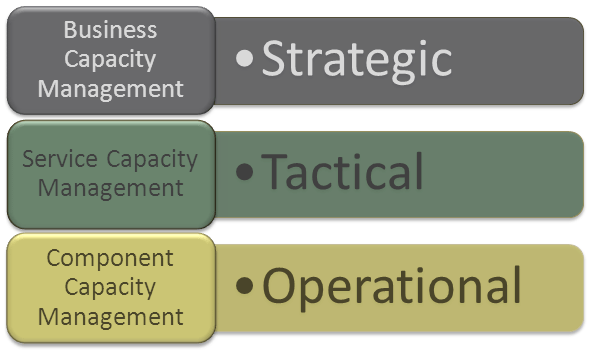I once witnessed a case when a telecom company offered a mobile subscription package for a “flat rate”. Plenty of minutes and MBs of data traffic were included in subscription fee. Result: response to the offer (which was, by the way, not that cheap) exceeded even the most optimistic expectations. Excellent? No! Since no one expected such an increase in demand for service, they did not plan for it, or for the required additional capacity. In the end, they had to decrease the quality of service and, after a while, most of the subscribers changed. Either subscriber plan or mobile operator.

Capacity Management components
There are many parameters that need to be considered when designing a service (or architecture). One to be considered right at the beginning is to satisfy demand for the service by providing enough capacity. Easier said than done.
The task of Capacity Management is to provide enough capacity to satisfy capacity and performance requirements. It should be timely and cost-effective. You noticed that performance is mentioned here – Capacity Management is often connected with performance.
Capacity Management is a quite complex process. It includes proactive (e.g. forestall capacity issues) and reactive measures (e.g. responding to capacity events) and it is highly technical. To make it easier, ITIL suggests three sub-processes:
- Business Capacity Management
- Service Capacity Management
- Component Capacity Management
Business Capacity Management
Business Capacity Management translates business plans and needs into requirements for IT services and architecture. As customers’ business changes, so are service requirements changing. Change in service requirements usually has an impact on demand for capacity. Service Level Requirements and Service Level Agreement targets must be met.
Business Capacity Management should predict changing requirements for capacity demand and manage such demand on a tactical level. This means that Capacity Management is involved in planning processes as well as financial and service level management processes. In such a way, information flow will enable capacity management to satisfy future business needs. I am familiar with an educational institution that is changing from the conservative approach of a blackboard and students’ notebooks to an interactive learning room approach, with laptops and “smart” whiteboards. In this case, there are a lot of requirements to be considered regarding capacity management so that, when the new school year starts, everything is up and running.
Service Capacity Management
Service Capacity Management focuses on management, control and prediction of end-to-end performance of live IT services usage and workloads. It’s about measuring performance and comparing it to requirements that are set in Service Level Agreements (SLAs) or Service Level Requirements (SLRs). Services are monitored to gather data, which identify trends and indicate exceptional conditions. This sub-process is often found in the Network Operations Center (NOC) or similar facility. Tools are used to help technicians (like IT Operations) to detect, for example, peaks in service usage, load, trends, etc. In such a way, incidents can be prevented before they occur, or data important for incident resolution can be gathered in cases when capacity-related incidents take place.
Component Capacity Management
Component capacity is what most of us are familiar with. Open your computer properties and check hard disc storage capacity. Or, ask your ISP what your internet link throughput is. We speak about component capacity. Component Capacity Management focuses on management, control, performance prediction, utilization and capacity of technology components (e.g. a hard disc, network interface, processor, etc.). Like in Service Capacity Management, there are reactive and proactive activities within the scope of Component Capacity Management. Reactive activities will be taken when a capacity-related incident occurs. Experience and knowledge about service usage and how services are utilizing components is crucial for efficient proactive Component Capacity Management.
Which capacity to consider?
Well, all three of them. Depending on where your activities are, you will be more concerned with one of the sub-processes. If you are strictly operational, then Component Capacity Management will be your daily job. Service Level Managers are concerned with performance that service provides. They will not go deep into details like what is memory utilization compared to its capacity (Component Capacity Management). What they care about is if, for example, throughput corresponds to the SLRs or SLAs that organization is obliged to. Business Capacity Management is the concern of people inside an organization who are trying to generate income with services (and their capacity and performance) that organization provides.
Early involvement
Capacity Management, according to ITIL, belongs to the Service Design phase of a service lifecycle.
But, when should you start considering capacity? It’s hard to say, but certainly – as soon as possible. Don’t leave it as a last “tick in the box,” because that is much too late. And it could be expensive.
Download a free sample of our Capacity Management process template to see how the process, plan, and measurement report can be established.

 Branimir Valentic
Branimir Valentic 



